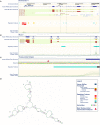Leukemogenic rearrangements at the mixed lineage leukemia gene (MLL)-multiple rather than a single mechanism
- PMID: 26161385
- PMCID: PMC4479792
- DOI: 10.3389/fcell.2015.00041
Leukemogenic rearrangements at the mixed lineage leukemia gene (MLL)-multiple rather than a single mechanism
Abstract
Despite manifold efforts to achieve reduced-intensity and -toxicity regimens, secondary leukemia has remained the most severe side effect of chemotherapeutic cancer treatment. Rearrangements involving a short telomeric <1 kb region of the mixed lineage leukemia (MLL) gene are the most frequently observed molecular changes in secondary as well as infant acute leukemia. Due to the mode-of-action of epipodophyllotoxins and anthracyclines, which have widely been used in cancer therapy, and support from in vitro experiments, cleavage of this MLL breakpoint cluster hotspot by poisoned topoisomerase II was proposed to trigger the molecular events leading to malignant transformation. Later on, clinical patient data and cell-based studies addressing a wider spectrum of stimuli identified cellular stress signaling pathways, which create secondary DNA structures, provide chromatin accessibility, and activate nucleases other than topoisomerase II at the MLL. The MLL destabilizing signaling pathways under discussion, namely early apoptotic DNA fragmentation, transcription stalling, and replication stalling, may all act in concert upon infection-, transplantation-, or therapy-induced cell cycle entry of hematopoietic stem and progenitor cells (HSPCs), to permit misguided cleavage and error-prone DNA repair in the cell-of-leukemia-origin.
Keywords: MLL breakpoint cluster region; apoptosis; error-prone DNA repair; infant acute leukemia; replication stress; therapy-related leukemia.
Figures


References
-
- Al-Sudairy R., Al-Nasser A., Alsultan A., Al Ahmari A., Abosoudah I., Al-Hayek R., et al. . (2014). Clinical characteristics and treatment outcome of childhood acute lymphoblastic leukemia in Saudi Arabia: a multi-institutional retrospective national collaborative study. Pediatr. Blood Cancer 61, 74–80. 10.1002/pbc.24584 - DOI - PubMed
-
- Aplan P. D., Chervinsky D. S., Stanulla M., Burhans W. C. (1996). Site-specific DNA cleavage within the MLL breakpoint cluster region induced by topoisomerase II inhibitors. Blood 87, 2649–2658. - PubMed
Publication types
LinkOut - more resources
Full Text Sources
Other Literature Sources

